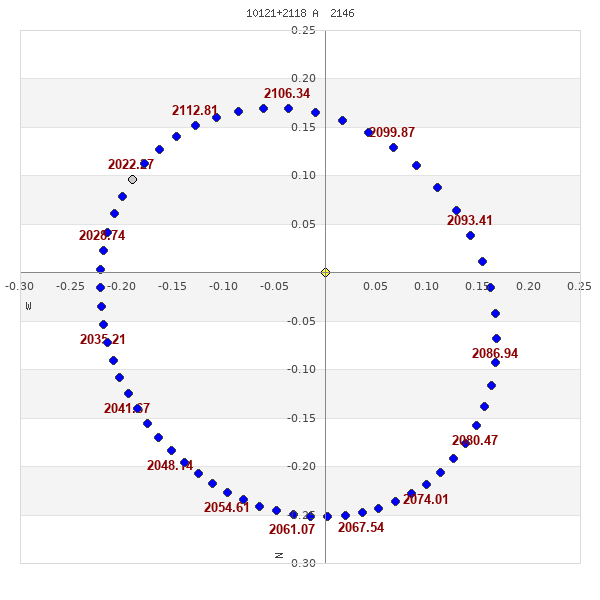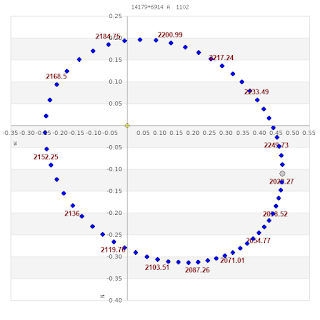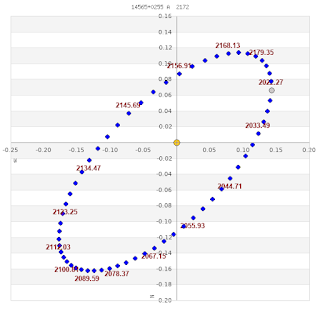BU 604 AC: 508; 150x: Bright white A, very faint C seen direct vision in the glow A casts off in poor transparency, very wide separation. Burnham discovered with the 18.5-inch. 15.7 mag AB not seen. WDS says not physical, and I can't find the Gaia data for the pair.
11h 49m 03.58s +14° 34' 19.4" P.A. 25.00 sep 101.2 mag 2.14,13.20 Sp A3V dist. 11 pc (35.88 l.y.)
A 2375 AB: 508; 600x: Clean, well split light orange stars, <1 Dm, PA to the south. WDS gives a 152.5-year period, nearing apastron and won't change much the next 20 years. Grade 3 orbit. There is -20% parallax range overlap, meaning none, and only 46 AU weighted separation and 1.0+1.0 Msol. It may eventually be found this is not truly a binary.
10h 58m 28.33s +17° 11' 06.2" P.A. 165.00 sep 0.5 mag 10.44,10.03 Sp G5 dist. 109.77 pc (358.07 l.y.)
HEI 360 AB: 508; 150x: Pretty, near equal white stars, well split around 4". WDS uncertain, but there is 26% parallax range overlap, 579 AU weighted separation, 1.1+1.0 Msol, and the radial velocity delta 0.0 is less than the escape velocity 2.5, so it is more than likely to be binary.
10h 59m 30.13s +12° 48' 05.5" P.A. 102.00 sep 3.8 mag 9.90,10.00 Sp G5
10h 59m 30.13s +12° 48' 05.5" P.A. 102.00 sep 3.8 mag 9.90,10.00 Sp G5
A 1773 AB: 508; 200x: Very nice white and 2 Dm close B, 2 Dm, PA NE, which was revealed while increasing magnification from 150x. WDS uncertain, but there is 33% parallax range overlap, 335 AU weighted separation, 1.4+1.0 Msol, so it is likely to be binary.
11h 03m 19.03s +23° 22' 36.5" P.A. 43.00 sep 2.4 mag 9.31,11.50 Sp G0
HO 48 AB: 508; 300x: Excellent pair, seen with 200x but better at 300x, white stars, 2 Dm B, nice and closely separated around 2". WDS uncertain, but there is 78% parallax range overlap (though with 9% error), 366 AU weighted separation, 1.9+1.1 Msol, so it is likely to be binary.
11h 03m 57.05s +23° 08' 51.3" P.A. 355.00 sep 1.8 mag 8.61,10.79 Sp G0 dist. 255.75 pc (834.26 l.y.)
STF1506 A-BC: 508; 150x: Typical Struve, light yellow A and wide blue B, 2 Dm. A676 BC is a component, I have hints of NS elongation at 600x but this might be atmopsheric dispersion. WDS says A-BC proper motion indicates physical, however there is no Gaia data for the B star(s).
11h 04m 41.47s -04° 13' 15.9" P.A. 224.00 sep 11.9 mag 7.68,10.15 Sp G5 dist. 26.27 pc (85.69 l.y.)
HU 885 AB: 508; 150x: Light orange stars, 2 Dm, 2" separation. WDS says physical, however there is no parallax range overlap, -43%, it is not binary.
11h 06m 31.58s +14° 15' 44.3" P.A. 254.00 sep 2.1 mag 9.42,10.93 Sp K2V dist. 42.03 pc (137.1 l.y.)
A 2146 AB: 508; 600x: Very subtly notched elongation, fainter bump to SW. WDS grade 4 orbit 94-year period. No parallax data for the primary.
10h 12m 05.05s +21° 17' 54.6" P.A. 238.90 sep 0.2 mag 9.74,9.59 Sp F8 dist. 210.97 pc (688.18 l.y.)
STF1606 AB: 508; 300x: Close but clean split, white stears, slight magnitude difference. WDS grade 4 orbit 1431-year period. No Gaia parallax for the primary.
12h 10m 47.34s +39° 53' 29.5" P.A. 139.10 sep 0.6 mag 7.44,7.93 Sp A8III dist. 120.19 pc (392.06 l.y.)
HU 736 AB: 508; 600x: Hairline split, white stars, 1 Dm, with seeing. WDS grade 4 orbit 245-year period. No Gaia parallax data for the primary.
12h 16m 00.42s +48° 06' 58.4" P.A. 177.10 sep 0.3 mag 9.57,9.99 Sp F8 dist. 123.15 pc (401.72 l.y.)
HU 641 AB: 508; 550x: Excellent hairline split of faint stars, with seeing. WDS grade 5 orbit 323-year period. No Gaia data for the secondary.
12h 57m 53.94s +49° 48' 16.8" P.A. 290.30 sep 0.3 mag 10.30,10.30 Sp K3III
12h 57m 53.94s +49° 48' 16.8" P.A. 290.30 sep 0.3 mag 10.30,10.30 Sp K3III
STT 278 AB: 508; 600x: Perfect airy discs, white stars, 1 Dm, a bit more than a hairline split. WDS grade 3 orbit, 506-year period. I don't find the Gaia data.
14h 12m 14.66s +44° 11' 22.5" P.A. 269.60 sep 0.4 mag 8.43,8.76 Sp F2IV dist. 192.68 pc (628.52 l.y.)
14h 12m 14.66s +44° 11' 22.5" P.A. 269.60 sep 0.4 mag 8.43,8.76 Sp F2IV dist. 192.68 pc (628.52 l.y.)
SWI 1 AB: 508; 150x: Ordinary equal 10th magnitude white stars, 3" separation. This is a Lewis Swift double; better known for his deep sky discoveries, he has two other doubles, both in Draco. WDS grade 4 orbit 1278-year period. Sadly there is no parallax range overlap (-4%), so in spite of the very small 42 AU weighted separation, 0.4+0.4 Msol, it may not be binary.
14h 02m 33.18s +46° 20' 23.9" P.A. 25.70 sep 3.7 mag 10.05,10.26 Sp M2+M2.5
ES 608 AB: 508; 200x: Very lovely light yellow-orange A, 2 Dm B, closely split about 1". HJ 2667 is a near an equal wide pair in the FOV 7' to the north. WDS grade 5 orbit, 322-year period. There is an 86% overlap of the pair's parallax ranges, a mere 43 AU weighted separation, and 0.5+0.4 Msol, only 72 ly distant, and surely a binary.
13h 37m 51.20s +48° 08' 17.2" P.A. 343.40 sep 1.4 mag 10.28,11.49 Sp M0.5+M1.5 dist. 22.14 pc (72.22 l.y.)
13h 37m 51.20s +48° 08' 17.2" P.A. 343.40 sep 1.4 mag 10.28,11.49 Sp M0.5+M1.5 dist. 22.14 pc (72.22 l.y.)
A 1102 AB: 508; 550x: Nice close split, near equal white stars. Suspected at 300x. WDS grade 4 orbit, 243-year period. I don't find Gaia data for the primary.
14h 17m 52.83s +69° 14' 03.5" P.A. 77.60 sep 0.5 mag 9.33,8.65 Sp F2 dist. 182.48 pc (595.25 l.y.)
STF1621 AB: 508; 300x: 1 Dm, nearly 2" separation, light orange stars. WDS grade 4 orbit, 1379-year period. There is 83% overlap of their parallax ranges, only 45 AU weighted separation, 0.6+0.6 Msol, very likely a binary.
12h 15m 58.34s +05° 38' 24.8" P.A. 49.50 sep 1.8 mag 10.22,10.59 Sp K8 dist. 28.99 pc (94.57 l.y.)
12h 15m 58.34s +05° 38' 24.8" P.A. 49.50 sep 1.8 mag 10.22,10.59 Sp K8 dist. 28.99 pc (94.57 l.y.)
STF1647 AB: 508; 200x: Near equal white stars, >1" separation. WDS grade 4 orbit, 1010-year period. However the stars do not share their parallax ranges, -8% overlap, so in spite of the mere 130 AU weighted separation and 1.5+1.4 Msol, it likely is not binary.
12h 30m 33.75s +09° 42' 56.4" P.A. 249.50 sep 1.3 mag 8.09,8.37 Sp F2 dist. 92.51 pc (301.77 l.y.)
12h 30m 33.75s +09° 42' 56.4" P.A. 249.50 sep 1.3 mag 8.09,8.37 Sp F2 dist. 92.51 pc (301.77 l.y.)
HU 138 AB: 508; 600x: Faint pair, near equal, well split when resolved to good discs with seeing. WDS grade 4 orbit, 151.4-year period, it will tighten 0.1" in the next 20 years. No Gaia parallax data for the primary.
14h 16m 00.46s -07° 03' 43.4" P.A. 216.60 sep 0.6 mag 9.80,9.79 Sp K0 dist. 68.73 pc (224.2 l.y.)
14h 16m 00.46s -07° 03' 43.4" P.A. 216.60 sep 0.6 mag 9.80,9.79 Sp K0 dist. 68.73 pc (224.2 l.y.)
STF1876 AB: 508; 200x: Slightly unequal white stars, nice close split >1". WDS grade 4 orbit, 966-year period, they unfortunately do not share their parallax ranges (-17% overlap), 104 AU weighted separation, 1.3+1.2 Msol, likely is not a binary.
14h 46m 21.64s -07° 22' 48.7" P.A. 114.80 sep 1.3 mag 8.46,8.62 Sp G0
14h 46m 21.64s -07° 22' 48.7" P.A. 114.80 sep 1.3 mag 8.46,8.62 Sp G0
A 2172 AB: 508; 600x: Out of round, but too tough to pin down a position angle, I guess south or east [actually ESE]. WDS grade 3 orbit, 168-year period, it will shift to the NE by the 2040s but become quite difficult to detect. No Gaia parallax data for the primary.
14h 56m 30.89s +02° 55' 12.2" P.A. 116.60 sep 0.2 mag 8.00,8.60 Sp K0
14h 56m 30.89s +02° 55' 12.2" P.A. 116.60 sep 0.2 mag 8.00,8.60 Sp K0
A 2074 AB: 508; 600x: Overlapping discs / snowman at best moments, PA to the west, 1 Dm. WDS grade 4 orbit, 59-year period. At apastron now, it will close rapidly in the coming years and make a dramatic close pass in 2040. No Gaia parallax data for the primary.
15h 27m 20.82s +17° 38' 06.3" P.A. 269.30 sep 0.3 mag 8.55,9.37 Sp F8 dist. 90.74 pc (295.99 l.y.)

















